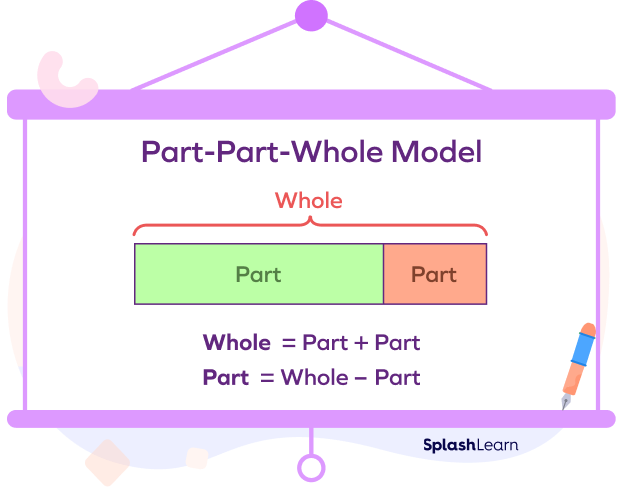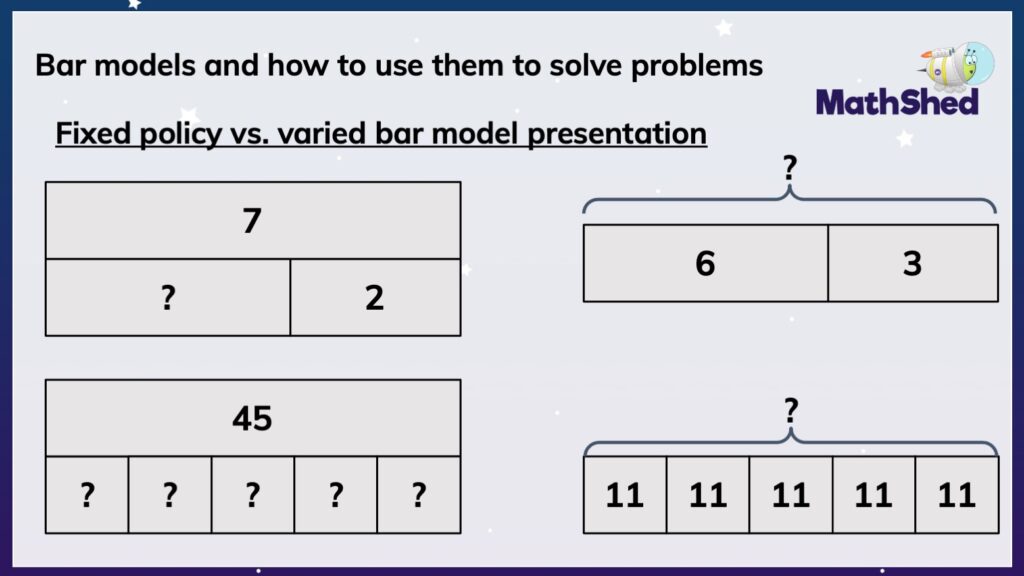Top tips for mastering bar model drawing techniques in math instruction
Wiki Article
Exploring Bar Version Illustration Techniques: A Comprehensive Guide to Envisioning Mathematics Concepts
Bar design drawing techniques function as an important source for both instructors and students in visualizing mathematical ideas. These designs simplify complex mathematical partnerships, aiding in the comprehension of enhancement, multiplication, division, and subtraction. This guide describes reliable techniques for implementing bar versions, promoting active involvement and real-world connections. As visitors explore the sensible applications and mentor tips, they will certainly discover just how these techniques can change their method to mathematics.Comprehending the Fundamentals of Bar Model Drawing
Bar design drawing offers as a powerful aesthetic tool in mathematics, facilitating the understanding of analytical methods and mathematical connections. This technique entails representing numbers and their partnerships via rectangle-shaped bars, making it much easier to envision procedures such as enhancement, reproduction, division, and subtraction. Each bar's length represents a certain worth, allowing students to contrast quantities and understand proportions plainly.To develop a bar model, one starts by recognizing the problem's crucial elements, often simplifying right into parts that can be aesthetically represented. As an example, in a basic enhancement issue, two bars can be attracted, with their lengths representing the addends. The combined size highlights the amount. Furthermore, bar versions can be adjusted for a lot more intricate issues, including proportions and fractions, by readjusting benches appropriately. Mastering these basics lays a solid structure for reliable analytical and much deeper mathematical understanding.
Advantages of Making Use Of Bar Models in Mathematics
Making use of bar versions in mathematics provides numerous benefits that boost knowing and comprehension. These visual depictions aid pupils in comprehending complex ideas by breaking them down into manageable elements. Bar models supply a clear structure for illustrating partnerships between numbers, making abstract ideas a lot more concrete. They promote a much deeper understanding of mathematical operations and facilitate problem-solving by allowing students to envision the information they are working with.Furthermore, bar designs support the advancement of critical believing abilities, as trainees have to analyze and interpret the visual info to draw conclusions. This technique urges energetic involvement with the material, reinforcing retention and proficiency of mathematical concepts. By cultivating a strong foundation in visual proficiency, bar designs equip students to approach various mathematical obstacles with confidence. On the whole, the integration of bar versions right into maths education confirms advantageous in cultivating both understanding and analytical capabilities amongst students.
Using Bar Designs to Enhancement and Subtraction
Bar versions work as an effective device for aesthetically representing addition and reduction problems. By showing the connection between numbers, they enhance understanding and promote analytic. Furthermore, real-life applications of these versions can aid students comprehend mathematical concepts in useful contexts.Representing Enhancement Visually
Aesthetic help can greatly improve their understanding of these operations when trainees run into addition and reduction troubles. Bar versions work as reliable tools for standing for enhancement. By separating a rectangular shape right into sectors that represent the numbers included, students can picture the relationship between the quantities. If a student requires to add 3 and 5, they can produce a bar split right into two sections: one section standing for 3 and the various other standing for 5. This clear representation not only simplifies the enhancement process yet likewise reinforces the concept of incorporating quantities. As pupils manipulate these visual aids, they establish a deeper understanding of enhancement, resulting in boosted problem-solving abilities and better self-confidence in their mathematical capacities.
Reduction With Bar Models
Reduction is typically viewed as a more complicated procedure than enhancement, bar models can successfully clarify this process for students. By aesthetically standing for the amounts entailed, pupils can much better comprehend how numbers connect to one an additional. In a bar version for subtraction, one bar represents the overall, while one more suggests the quantity being subtracted. This aesthetic distinction assists pupils comprehend the concept of "removing." As an example, if a bar shows 10 devices, and another bar standing for 4 devices is eliminated, trainees can easily see that 6 devices remain. This technique not only cultivates understanding of subtraction yet likewise aids in creating analytical abilities, enabling trainees to imagine their mathematical reasoning and boost their overall comprehension of mathematical concepts.Real-Life Application Examples
Comprehending reduction through bar models lays a structure for using these techniques in real-life circumstances. In various contexts, such as budgeting or shopping, people can picture just how much money remains after expenditures. For example, if an individual has $50 and invests $20, a bar model can represent the total quantity and the invested portion, highlighting that $30 is left. Additionally, moms and dads can use bar designs to assist kids understand the amount of more things need to be included to complete a collection, such as having 3 apples and needing five. This visual depiction streamlines complicated troubles, assisting in comprehension and retention. Ultimately, bar designs function as reliable devices in everyday decision-making, enhancing mathematical understanding in functional situations.Envisioning Multiplication and Department With Bar Versions
In checking out the application of bar models for reproduction and department, it is vital to understand their fundamental concepts. Creating reproduction models allows students to picture relationships in between numbers, while effective department methods can be illustrated via these visual help. This technique enhances understanding and problem-solving abilities in maths.Comprehending Bar Versions
Bar versions function as an effective aesthetic device for highlighting the concepts of reproduction and division. They allow students to represent mathematical connections in an organized layout, assisting in a much deeper understanding of these operations. In multiplication, bar versions present groups of equal dimension, permitting individuals to imagine the total quantity when combining these teams. On the other hand, in department, bar versions aid depict how a total is split into smaller, equivalent components, making clear the concept of partitioning. By utilizing these visual aids, students can understand the underlying concepts of multiplication and department better. This technique not just enhances understanding however additionally sustains analytic abilities, making bar models an indispensable property in mathematical education.Creating Multiplication Models
Constructing reproduction designs utilizing bar representations offers a clear approach for picturing the process of reproduction. These models enable students to stand for reproduction as groups of equivalent components, making abstract principles much more concrete. To highlight (3 times 4), a student can attract one bar divided right into three equal sections, each standing for 4 units. Additionally, creating a second bar with the exact same size strengthens the understanding of repeated addition, as each sector corresponds to one group. This graph not only help in grasping multiplication but likewise enhances analytic abilities. By using bar models, students can much better understand partnerships between numbers and establish a robust structure for more complex mathematical concepts, leading to enhanced self-confidence in their abilities.Envisioning Department Methods

Resolving Word Troubles Using Bar Design Techniques

In a trouble including enhancement and reduction, students can draw separate bars for each quantity and then adjust them to discover the option. This procedure not just makes clear the trouble yet additionally cultivates a much deeper conceptual understanding. Bar versions can be adapted for various kinds of word problems, making them functional across different mathematical subjects. Eventually, utilizing bar versions can considerably enhance students' analytic skills by giving a clear visual path to get to the correct response.
Integrating Bar Versions in Different Mathematics Topics
Bar models can be effortlessly incorporated right into numerous math topics, enhancing pupils' understanding of ideas beyond standard math. In algebra, these aesthetic devices help in standing for formulas and inequalities, enabling learners to imagine connections in between variables. When tackling geometry, bar models can illustrate the residential or commercial properties of forms and spatial thinking, helping trainees realize principles like location and perimeter successfully. In data, bar versions facilitate the analysis of information collections, allowing trainees to contrast quantities and acknowledge patterns visually. Furthermore, incorporating bar versions within measurement topics aids in recognizing devices and conversions by providing a substantial representation of amounts. By using bar models throughout different mathematical areas, educators can promote a deeper comprehension of complicated ideas, consequently boosting analytical skills and advertising critical thinking (bar model drawing techniques). This adaptability demonstrates the utility website of bar versions as a foundational device for pupils in their mathematical journeyTips for Teaching Bar Designs Properly
Integrating bar models into training techniques needs thoughtful methods to maximize their efficiency. Educators should start by introducing bar models with basic, relatable examples that students can easily understand. This assists to construct confidence and familiarity with the idea. Gradually boosting the complexity of troubles enables learners to use their skills progressively. Additionally, teachers ought to encourage students to create their own bar designs, advertising energetic involvement and possession of their discovering.Incorporating collective activities can also improve understanding, as trainees discuss and fix issues in groups. Continuous feedback is vital; teachers should give useful discourse on students' bar model representations to assist improvement. Linking bar versions to real-life situations reinforces their significance, assisting trainees see the functional applications of their mathematical skills. By applying these strategies, teachers can successfully harness the power of bar models in their mathematics direction.
Often Asked Questions
Can Bar Models Be Utilized in Various Other Topics Besides Math?
Bar designs can without a doubt be made use of in various topics beyond mathematics. They successfully illustrate ideas in scientific research, social research studies, and language arts, aiding to aesthetically stand for connections, procedures, and concepts for enhanced understanding throughout self-controls.What Age Is Ideal Fit for Discovering Bar Versions?
Bar designs are best suited for youngsters ages 7 to 12, as they develop concrete reasoning abilities throughout this duration (bar model drawing techniques). At this age, pupils can efficiently comprehend abstract principles with graph and problem-solving methodsAre There Digital Devices for Creating Bar Versions?

Exactly How Can I Examine Trainee Comprehending of Bar Models?
Examining pupil understanding of bar models can involve tests, observational assessments, and group conversations. Educators might additionally examine students' finished versions and their ability to explain their reasoning, making sure an extensive evaluation of understanding.What Prevail Mistakes When Using Bar Versions?
Typical mistakes when using bar designs consist of misstating quantities, failing to precisely identify bars, confusing enhancement and subtraction, overlooking to utilize consistent scales, and neglecting the significance of clear visual separation between various aspects.In addition, bar models can be adapted for a lot more complex troubles, consisting of fractions and proportions, by changing the bars appropriately. Subtraction is typically regarded as a more complicated operation than addition, bar versions can successfully clarify this process for trainees. In a bar design for subtraction, one bar stands for the total, while one more suggests the amount being subtracted. If a bar shows 10 devices, and an additional bar representing 4 units is eliminated, trainees can conveniently see that 6 devices remain. When splitting a total amount right into equal teams, students can draw a lengthy bar to represent the entire and after that sector it right into smaller bars that show each group.
Report this wiki page